Corporate Finance Report: Sainsbury's Equity Valuation and Analysis
VerifiedAdded on 2020/06/06
|15
|2381
|46
Report
AI Summary
This report provides a comprehensive analysis of Sainsbury's equity valuation within the framework of corporate finance. It begins with ratio analysis, comparing Sainsbury's financial performance to competitors like Morrison's and Tesco, focusing on earnings per share, dividends, ROCE, and ROE to assess shareholder value. The report then examines share price performance and dividend trends over time, followed by an evaluation using EVA and the Gordon growth model. Further, it delves into various valuation methods, including net asset value, discounted free cash flow (DCF), and PE ratio analysis, to determine the intrinsic value of Sainsbury's shares. The DCF model is used to forecast revenues, costs, and free cash flows, with a detailed cost sheet and WACC calculation. The report concludes by comparing the results of different valuation methods and discusses the reasons for any discrepancies, highlighting the accuracy of the DCF method. The report assesses whether Sainsbury's shares are overvalued or undervalued in the market and provides insights into investment decisions based on these findings.
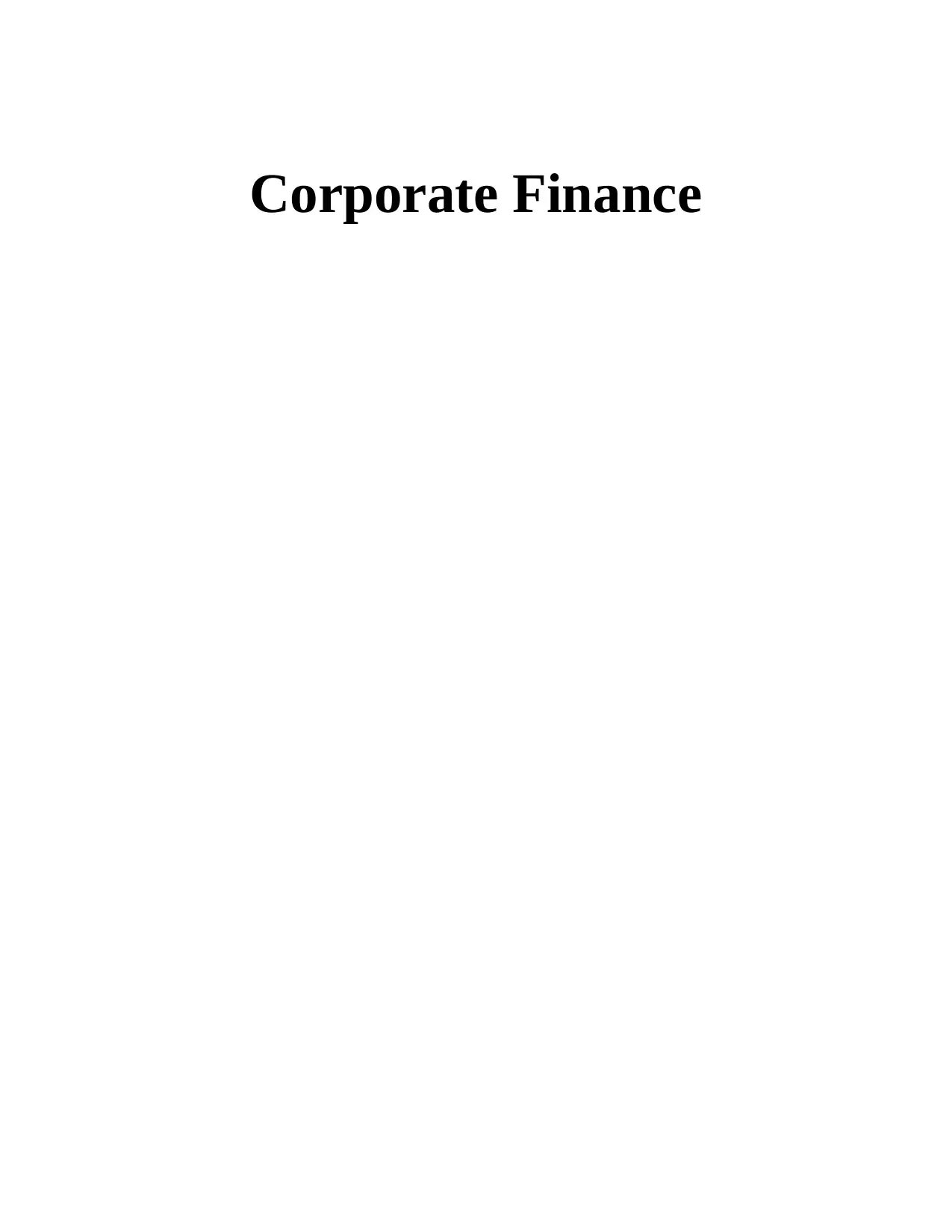
Corporate Finance
Paraphrase This Document
Need a fresh take? Get an instant paraphrase of this document with our AI Paraphraser

TABLE OF CONTENTS
INTRODUCTION...........................................................................................................................4
Part 1................................................................................................................................................4
Ratio analysis that aid in the decision making of shareholders...................................................4
Total shareholder analysis...........................................................................................................5
Share price performance and dividend paid over time period.....................................................6
EVA analysis and Gordon growth model....................................................................................7
Part 2................................................................................................................................................7
Share price development of firms and comparison with index...................................................7
Part 3................................................................................................................................................8
Valuation methods.......................................................................................................................8
Assets that need to be revalued on basis of statement of 2011 and 2012....................................9
Presenting the equity valuation of Sainsbury..............................................................................9
Discounted free cash flow model or analysis..............................................................................9
PE ratio valuation......................................................................................................................13
Reasons for difference in price..................................................................................................13
CONCLUSION..............................................................................................................................13
REFERENCES..............................................................................................................................14
APPENDIX....................................................................................................................................15
INTRODUCTION...........................................................................................................................4
Part 1................................................................................................................................................4
Ratio analysis that aid in the decision making of shareholders...................................................4
Total shareholder analysis...........................................................................................................5
Share price performance and dividend paid over time period.....................................................6
EVA analysis and Gordon growth model....................................................................................7
Part 2................................................................................................................................................7
Share price development of firms and comparison with index...................................................7
Part 3................................................................................................................................................8
Valuation methods.......................................................................................................................8
Assets that need to be revalued on basis of statement of 2011 and 2012....................................9
Presenting the equity valuation of Sainsbury..............................................................................9
Discounted free cash flow model or analysis..............................................................................9
PE ratio valuation......................................................................................................................13
Reasons for difference in price..................................................................................................13
CONCLUSION..............................................................................................................................13
REFERENCES..............................................................................................................................14
APPENDIX....................................................................................................................................15
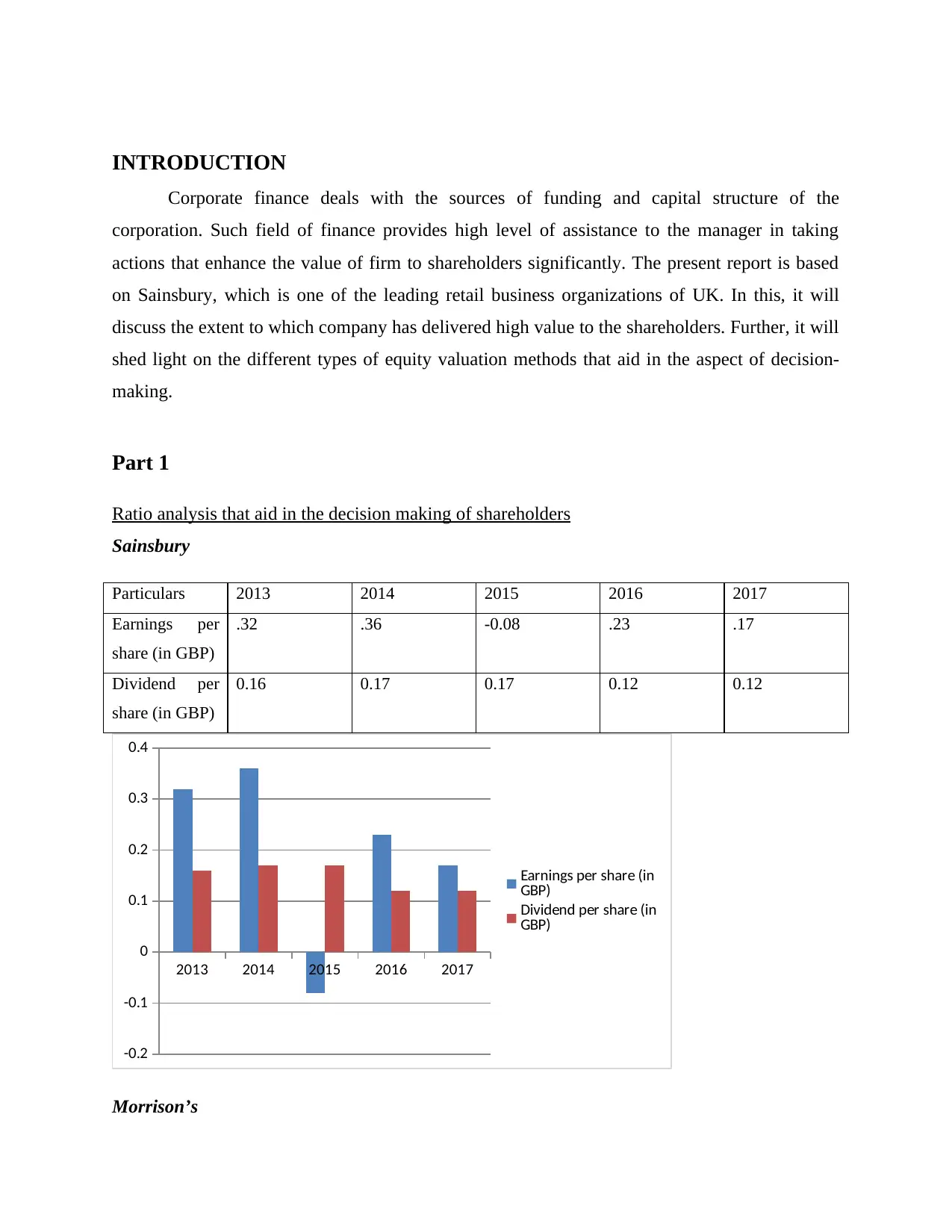
INTRODUCTION
Corporate finance deals with the sources of funding and capital structure of the
corporation. Such field of finance provides high level of assistance to the manager in taking
actions that enhance the value of firm to shareholders significantly. The present report is based
on Sainsbury, which is one of the leading retail business organizations of UK. In this, it will
discuss the extent to which company has delivered high value to the shareholders. Further, it will
shed light on the different types of equity valuation methods that aid in the aspect of decision-
making.
Part 1
Ratio analysis that aid in the decision making of shareholders
Sainsbury
Particulars 2013 2014 2015 2016 2017
Earnings per
share (in GBP)
.32 .36 -0.08 .23 .17
Dividend per
share (in GBP)
0.16 0.17 0.17 0.12 0.12
2013 2014 2015 2016 2017
-0.2
-0.1
0
0.1
Corporate finance deals with the sources of funding and capital structure of the
corporation. Such field of finance provides high level of assistance to the manager in taking
actions that enhance the value of firm to shareholders significantly. The present report is based
on Sainsbury, which is one of the leading retail business organizations of UK. In this, it will
discuss the extent to which company has delivered high value to the shareholders. Further, it will
shed light on the different types of equity valuation methods that aid in the aspect of decision-
making.
Part 1
Ratio analysis that aid in the decision making of shareholders
Sainsbury
Particulars 2013 2014 2015 2016 2017
Earnings per
share (in GBP)
.32 .36 -0.08 .23 .17
Dividend per
share (in GBP)
0.16 0.17 0.17 0.12 0.12
2013 2014 2015 2016 2017
-0.2
-0.1
0
0.1
⊘ This is a preview!⊘
Do you want full access?
Subscribe today to unlock all pages.

Trusted by 1+ million students worldwide
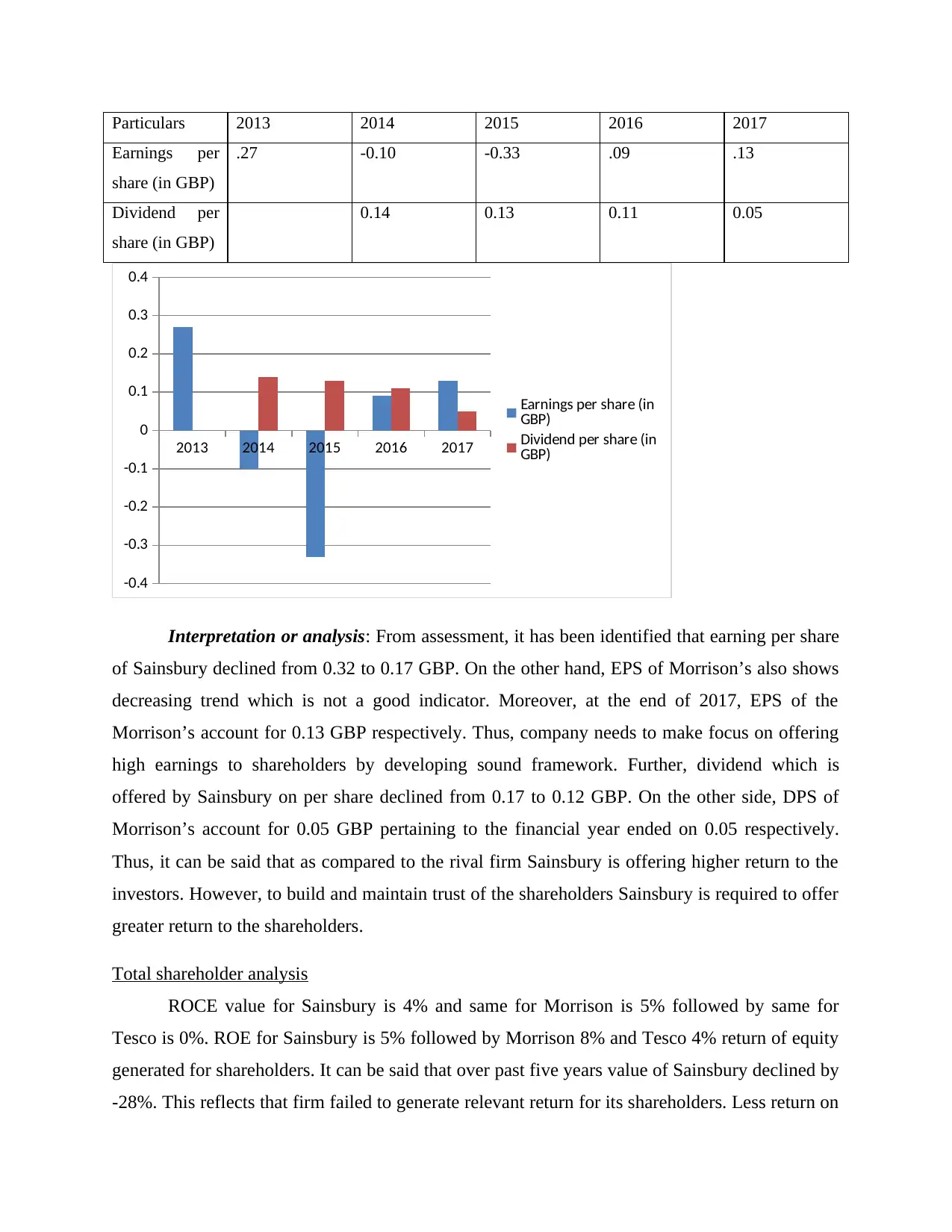
Particulars 2013 2014 2015 2016 2017
Earnings per
share (in GBP)
.27 -0.10 -0.33 .09 .13
Dividend per
share (in GBP)
0.14 0.13 0.11 0.05
2013 2014 2015 2016 2017
-0.4
-0.3
-0.2
-0.1
0
0.1
0.2
0.3
0.4
Earnings per share (in
GBP)
Dividend per share (in
GBP)
Interpretation or analysis: From assessment, it has been identified that earning per share
of Sainsbury declined from 0.32 to 0.17 GBP. On the other hand, EPS of Morrison’s also shows
decreasing trend which is not a good indicator. Moreover, at the end of 2017, EPS of the
Morrison’s account for 0.13 GBP respectively. Thus, company needs to make focus on offering
high earnings to shareholders by developing sound framework. Further, dividend which is
offered by Sainsbury on per share declined from 0.17 to 0.12 GBP. On the other side, DPS of
Morrison’s account for 0.05 GBP pertaining to the financial year ended on 0.05 respectively.
Thus, it can be said that as compared to the rival firm Sainsbury is offering higher return to the
investors. However, to build and maintain trust of the shareholders Sainsbury is required to offer
greater return to the shareholders.
Total shareholder analysis
ROCE value for Sainsbury is 4% and same for Morrison is 5% followed by same for
Earnings per
share (in GBP)
.27 -0.10 -0.33 .09 .13
Dividend per
share (in GBP)
0.14 0.13 0.11 0.05
2013 2014 2015 2016 2017
-0.4
-0.3
-0.2
-0.1
0
0.1
0.2
0.3
0.4
Earnings per share (in
GBP)
Dividend per share (in
GBP)
Interpretation or analysis: From assessment, it has been identified that earning per share
of Sainsbury declined from 0.32 to 0.17 GBP. On the other hand, EPS of Morrison’s also shows
decreasing trend which is not a good indicator. Moreover, at the end of 2017, EPS of the
Morrison’s account for 0.13 GBP respectively. Thus, company needs to make focus on offering
high earnings to shareholders by developing sound framework. Further, dividend which is
offered by Sainsbury on per share declined from 0.17 to 0.12 GBP. On the other side, DPS of
Morrison’s account for 0.05 GBP pertaining to the financial year ended on 0.05 respectively.
Thus, it can be said that as compared to the rival firm Sainsbury is offering higher return to the
investors. However, to build and maintain trust of the shareholders Sainsbury is required to offer
greater return to the shareholders.
Total shareholder analysis
ROCE value for Sainsbury is 4% and same for Morrison is 5% followed by same for
Paraphrase This Document
Need a fresh take? Get an instant paraphrase of this document with our AI Paraphraser
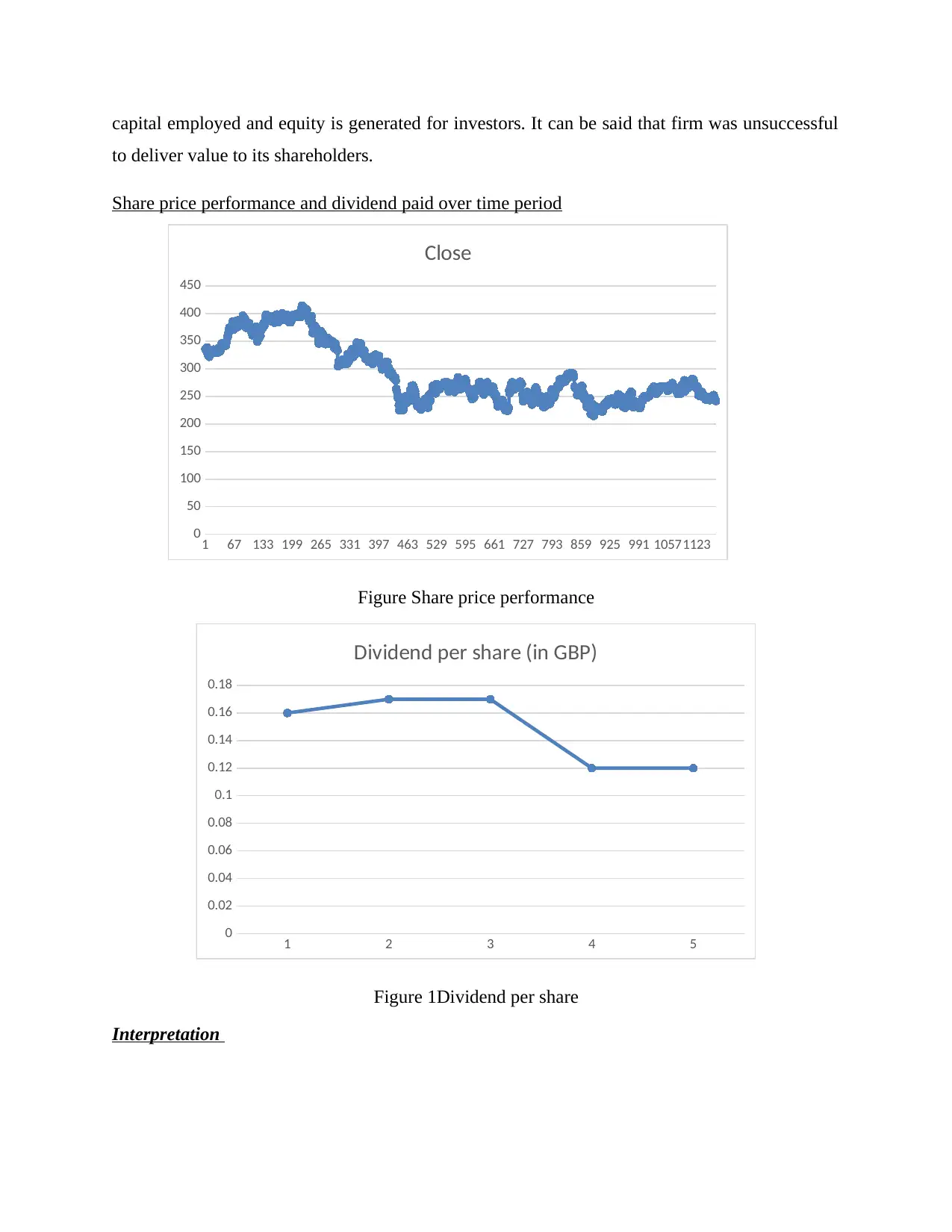
capital employed and equity is generated for investors. It can be said that firm was unsuccessful
to deliver value to its shareholders.
Share price performance and dividend paid over time period
1 67 133 199 265 331 397 463 529 595 661 727 793 859 925 991 10571123
0
50
100
150
200
250
300
350
400
450
Close
Figure Share price performance
1 2 3 4 5
0
0.02
0.04
0.06
0.08
0.1
0.12
0.14
0.16
0.18
Dividend per share (in GBP)
Figure 1Dividend per share
Interpretation
to deliver value to its shareholders.
Share price performance and dividend paid over time period
1 67 133 199 265 331 397 463 529 595 661 727 793 859 925 991 10571123
0
50
100
150
200
250
300
350
400
450
Close
Figure Share price performance
1 2 3 4 5
0
0.02
0.04
0.06
0.08
0.1
0.12
0.14
0.16
0.18
Dividend per share (in GBP)
Figure 1Dividend per share
Interpretation
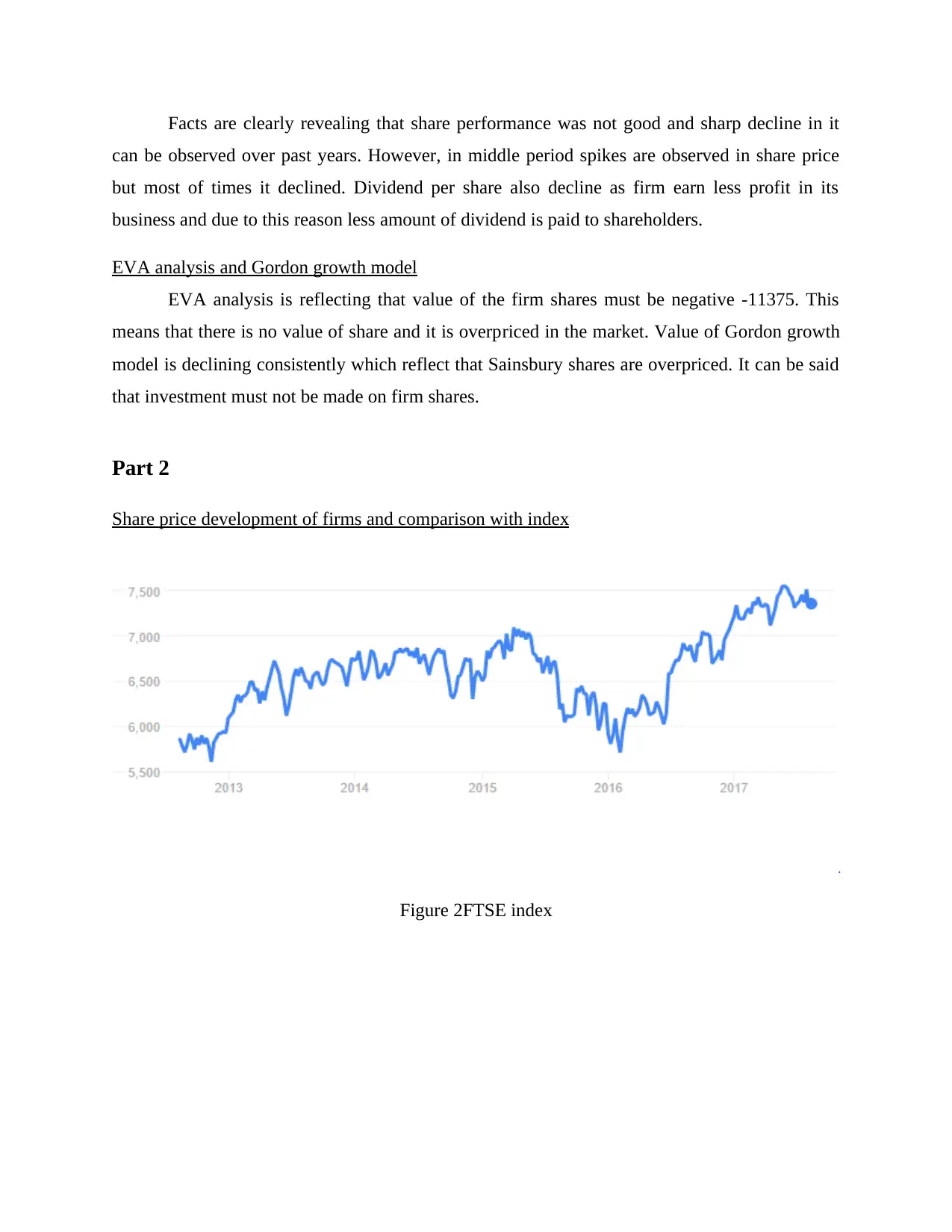
Facts are clearly revealing that share performance was not good and sharp decline in it
can be observed over past years. However, in middle period spikes are observed in share price
but most of times it declined. Dividend per share also decline as firm earn less profit in its
business and due to this reason less amount of dividend is paid to shareholders.
EVA analysis and Gordon growth model
EVA analysis is reflecting that value of the firm shares must be negative -11375. This
means that there is no value of share and it is overpriced in the market. Value of Gordon growth
model is declining consistently which reflect that Sainsbury shares are overpriced. It can be said
that investment must not be made on firm shares.
Part 2
Share price development of firms and comparison with index
Figure 2FTSE index
can be observed over past years. However, in middle period spikes are observed in share price
but most of times it declined. Dividend per share also decline as firm earn less profit in its
business and due to this reason less amount of dividend is paid to shareholders.
EVA analysis and Gordon growth model
EVA analysis is reflecting that value of the firm shares must be negative -11375. This
means that there is no value of share and it is overpriced in the market. Value of Gordon growth
model is declining consistently which reflect that Sainsbury shares are overpriced. It can be said
that investment must not be made on firm shares.
Part 2
Share price development of firms and comparison with index
Figure 2FTSE index
⊘ This is a preview!⊘
Do you want full access?
Subscribe today to unlock all pages.

Trusted by 1+ million students worldwide
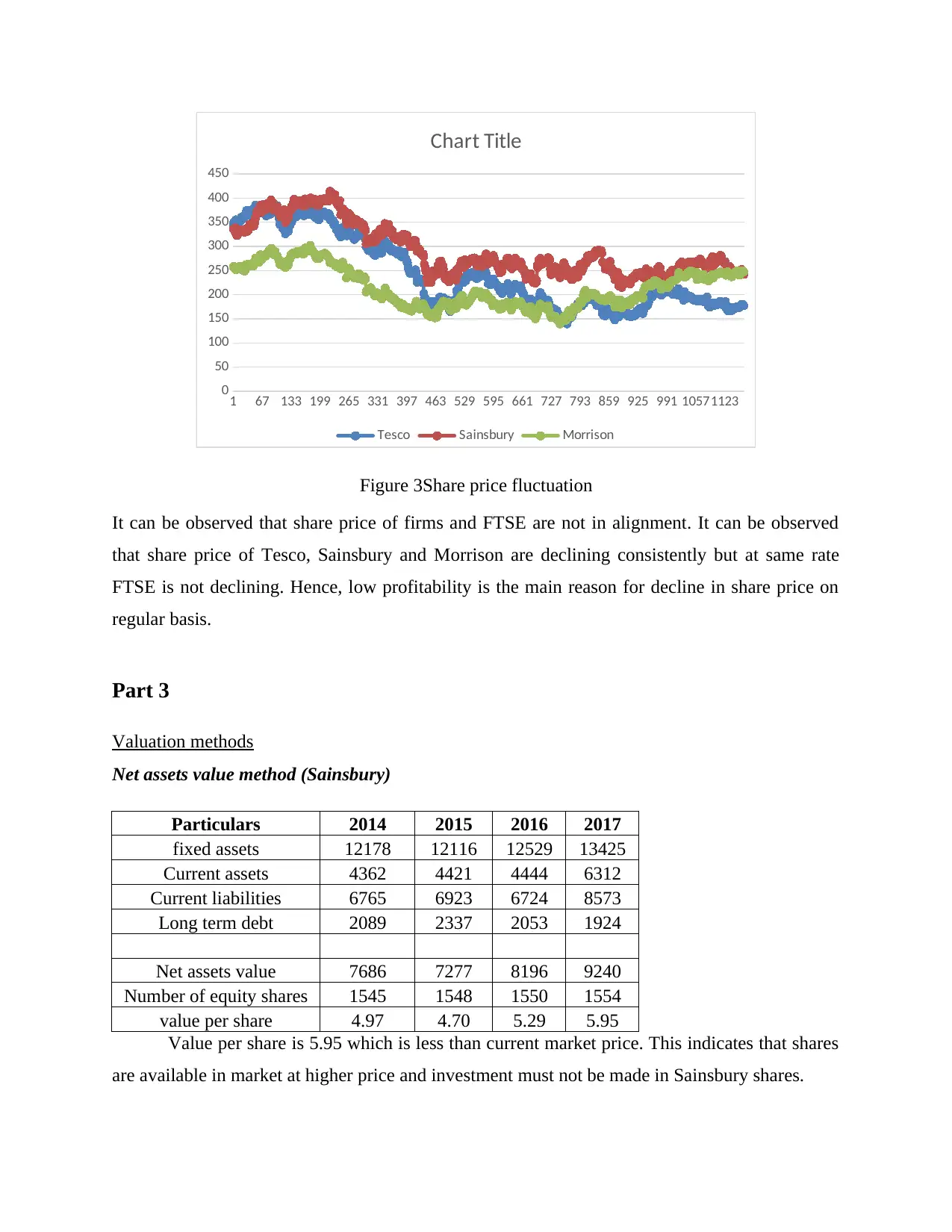
1 67 133 199 265 331 397 463 529 595 661 727 793 859 925 991 10571123
0
50
100
150
200
250
300
350
400
450
Chart Title
Tesco Sainsbury Morrison
Figure 3Share price fluctuation
It can be observed that share price of firms and FTSE are not in alignment. It can be observed
that share price of Tesco, Sainsbury and Morrison are declining consistently but at same rate
FTSE is not declining. Hence, low profitability is the main reason for decline in share price on
regular basis.
Part 3
Valuation methods
Net assets value method (Sainsbury)
Particulars 2014 2015 2016 2017
fixed assets 12178 12116 12529 13425
Current assets 4362 4421 4444 6312
Current liabilities 6765 6923 6724 8573
Long term debt 2089 2337 2053 1924
Net assets value 7686 7277 8196 9240
Number of equity shares 1545 1548 1550 1554
value per share 4.97 4.70 5.29 5.95
Value per share is 5.95 which is less than current market price. This indicates that shares
are available in market at higher price and investment must not be made in Sainsbury shares.
0
50
100
150
200
250
300
350
400
450
Chart Title
Tesco Sainsbury Morrison
Figure 3Share price fluctuation
It can be observed that share price of firms and FTSE are not in alignment. It can be observed
that share price of Tesco, Sainsbury and Morrison are declining consistently but at same rate
FTSE is not declining. Hence, low profitability is the main reason for decline in share price on
regular basis.
Part 3
Valuation methods
Net assets value method (Sainsbury)
Particulars 2014 2015 2016 2017
fixed assets 12178 12116 12529 13425
Current assets 4362 4421 4444 6312
Current liabilities 6765 6923 6724 8573
Long term debt 2089 2337 2053 1924
Net assets value 7686 7277 8196 9240
Number of equity shares 1545 1548 1550 1554
value per share 4.97 4.70 5.29 5.95
Value per share is 5.95 which is less than current market price. This indicates that shares
are available in market at higher price and investment must not be made in Sainsbury shares.
Paraphrase This Document
Need a fresh take? Get an instant paraphrase of this document with our AI Paraphraser
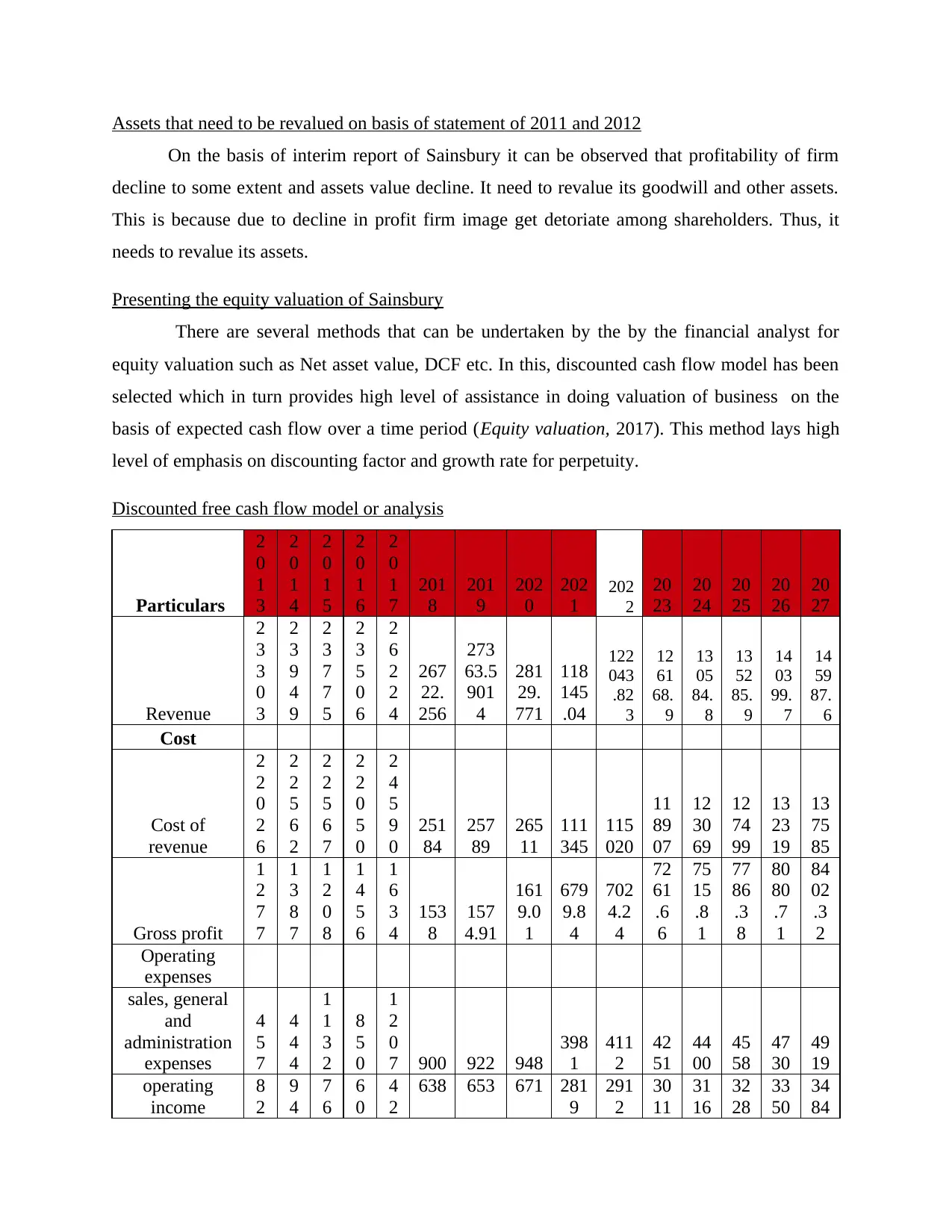
Assets that need to be revalued on basis of statement of 2011 and 2012
On the basis of interim report of Sainsbury it can be observed that profitability of firm
decline to some extent and assets value decline. It need to revalue its goodwill and other assets.
This is because due to decline in profit firm image get detoriate among shareholders. Thus, it
needs to revalue its assets.
Presenting the equity valuation of Sainsbury
There are several methods that can be undertaken by the by the financial analyst for
equity valuation such as Net asset value, DCF etc. In this, discounted cash flow model has been
selected which in turn provides high level of assistance in doing valuation of business on the
basis of expected cash flow over a time period (Equity valuation, 2017). This method lays high
level of emphasis on discounting factor and growth rate for perpetuity.
Discounted free cash flow model or analysis
Particulars
2
0
1
3
2
0
1
4
2
0
1
5
2
0
1
6
2
0
1
7
201
8
201
9
202
0
202
1
202
2
20
23
20
24
20
25
20
26
20
27
Revenue
2
3
3
0
3
2
3
9
4
9
2
3
7
7
5
2
3
5
0
6
2
6
2
2
4
267
22.
256
273
63.5
901
4
281
29.
771
118
145
.04
122
043
.82
3
12
61
68.
9
13
05
84.
8
13
52
85.
9
14
03
99.
7
14
59
87.
6
Cost
Cost of
revenue
2
2
0
2
6
2
2
5
6
2
2
2
5
6
7
2
2
0
5
0
2
4
5
9
0
251
84
257
89
265
11
111
345
115
020
11
89
07
12
30
69
12
74
99
13
23
19
13
75
85
Gross profit
1
2
7
7
1
3
8
7
1
2
0
8
1
4
5
6
1
6
3
4
153
8
157
4.91
161
9.0
1
679
9.8
4
702
4.2
4
72
61
.6
6
75
15
.8
1
77
86
.3
8
80
80
.7
1
84
02
.3
2
Operating
expenses
sales, general
and
administration
expenses
4
5
7
4
4
4
1
1
3
2
8
5
0
1
2
0
7 900 922 948
398
1
411
2
42
51
44
00
45
58
47
30
49
19
operating
income
8
2
9
4
7
6
6
0
4
2
638 653 671 281
9
291
2
30
11
31
16
32
28
33
50
34
84
On the basis of interim report of Sainsbury it can be observed that profitability of firm
decline to some extent and assets value decline. It need to revalue its goodwill and other assets.
This is because due to decline in profit firm image get detoriate among shareholders. Thus, it
needs to revalue its assets.
Presenting the equity valuation of Sainsbury
There are several methods that can be undertaken by the by the financial analyst for
equity valuation such as Net asset value, DCF etc. In this, discounted cash flow model has been
selected which in turn provides high level of assistance in doing valuation of business on the
basis of expected cash flow over a time period (Equity valuation, 2017). This method lays high
level of emphasis on discounting factor and growth rate for perpetuity.
Discounted free cash flow model or analysis
Particulars
2
0
1
3
2
0
1
4
2
0
1
5
2
0
1
6
2
0
1
7
201
8
201
9
202
0
202
1
202
2
20
23
20
24
20
25
20
26
20
27
Revenue
2
3
3
0
3
2
3
9
4
9
2
3
7
7
5
2
3
5
0
6
2
6
2
2
4
267
22.
256
273
63.5
901
4
281
29.
771
118
145
.04
122
043
.82
3
12
61
68.
9
13
05
84.
8
13
52
85.
9
14
03
99.
7
14
59
87.
6
Cost
Cost of
revenue
2
2
0
2
6
2
2
5
6
2
2
2
5
6
7
2
2
0
5
0
2
4
5
9
0
251
84
257
89
265
11
111
345
115
020
11
89
07
12
30
69
12
74
99
13
23
19
13
75
85
Gross profit
1
2
7
7
1
3
8
7
1
2
0
8
1
4
5
6
1
6
3
4
153
8
157
4.91
161
9.0
1
679
9.8
4
702
4.2
4
72
61
.6
6
75
15
.8
1
77
86
.3
8
80
80
.7
1
84
02
.3
2
Operating
expenses
sales, general
and
administration
expenses
4
5
7
4
4
4
1
1
3
2
8
5
0
1
2
0
7 900 922 948
398
1
411
2
42
51
44
00
45
58
47
30
49
19
operating
income
8
2
9
4
7
6
6
0
4
2
638 653 671 281
9
291
2
30
11
31
16
32
28
33
50
34
84
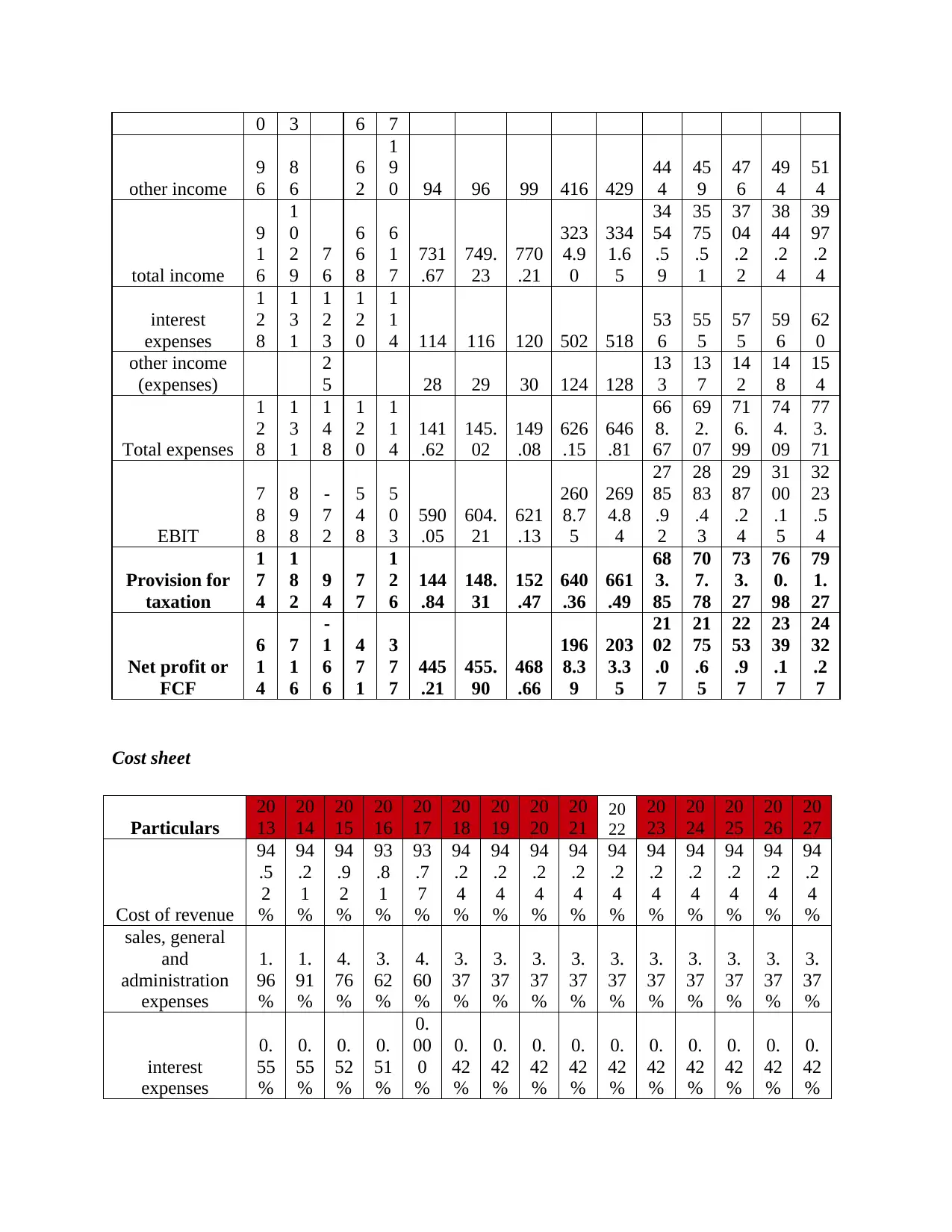
0 3 6 7
other income
9
6
8
6
6
2
1
9
0 94 96 99 416 429
44
4
45
9
47
6
49
4
51
4
total income
9
1
6
1
0
2
9
7
6
6
6
8
6
1
7
731
.67
749.
23
770
.21
323
4.9
0
334
1.6
5
34
54
.5
9
35
75
.5
1
37
04
.2
2
38
44
.2
4
39
97
.2
4
interest
expenses
1
2
8
1
3
1
1
2
3
1
2
0
1
1
4 114 116 120 502 518
53
6
55
5
57
5
59
6
62
0
other income
(expenses)
2
5 28 29 30 124 128
13
3
13
7
14
2
14
8
15
4
Total expenses
1
2
8
1
3
1
1
4
8
1
2
0
1
1
4
141
.62
145.
02
149
.08
626
.15
646
.81
66
8.
67
69
2.
07
71
6.
99
74
4.
09
77
3.
71
EBIT
7
8
8
8
9
8
-
7
2
5
4
8
5
0
3
590
.05
604.
21
621
.13
260
8.7
5
269
4.8
4
27
85
.9
2
28
83
.4
3
29
87
.2
4
31
00
.1
5
32
23
.5
4
Provision for
taxation
1
7
4
1
8
2
9
4
7
7
1
2
6
144
.84
148.
31
152
.47
640
.36
661
.49
68
3.
85
70
7.
78
73
3.
27
76
0.
98
79
1.
27
Net profit or
FCF
6
1
4
7
1
6
-
1
6
6
4
7
1
3
7
7
445
.21
455.
90
468
.66
196
8.3
9
203
3.3
5
21
02
.0
7
21
75
.6
5
22
53
.9
7
23
39
.1
7
24
32
.2
7
Cost sheet
Particulars
20
13
20
14
20
15
20
16
20
17
20
18
20
19
20
20
20
21
20
22
20
23
20
24
20
25
20
26
20
27
Cost of revenue
94
.5
2
%
94
.2
1
%
94
.9
2
%
93
.8
1
%
93
.7
7
%
94
.2
4
%
94
.2
4
%
94
.2
4
%
94
.2
4
%
94
.2
4
%
94
.2
4
%
94
.2
4
%
94
.2
4
%
94
.2
4
%
94
.2
4
%
sales, general
and
administration
expenses
1.
96
%
1.
91
%
4.
76
%
3.
62
%
4.
60
%
3.
37
%
3.
37
%
3.
37
%
3.
37
%
3.
37
%
3.
37
%
3.
37
%
3.
37
%
3.
37
%
3.
37
%
interest
expenses
0.
55
%
0.
55
%
0.
52
%
0.
51
%
0.
00
0
%
0.
42
%
0.
42
%
0.
42
%
0.
42
%
0.
42
%
0.
42
%
0.
42
%
0.
42
%
0.
42
%
0.
42
%
other income
9
6
8
6
6
2
1
9
0 94 96 99 416 429
44
4
45
9
47
6
49
4
51
4
total income
9
1
6
1
0
2
9
7
6
6
6
8
6
1
7
731
.67
749.
23
770
.21
323
4.9
0
334
1.6
5
34
54
.5
9
35
75
.5
1
37
04
.2
2
38
44
.2
4
39
97
.2
4
interest
expenses
1
2
8
1
3
1
1
2
3
1
2
0
1
1
4 114 116 120 502 518
53
6
55
5
57
5
59
6
62
0
other income
(expenses)
2
5 28 29 30 124 128
13
3
13
7
14
2
14
8
15
4
Total expenses
1
2
8
1
3
1
1
4
8
1
2
0
1
1
4
141
.62
145.
02
149
.08
626
.15
646
.81
66
8.
67
69
2.
07
71
6.
99
74
4.
09
77
3.
71
EBIT
7
8
8
8
9
8
-
7
2
5
4
8
5
0
3
590
.05
604.
21
621
.13
260
8.7
5
269
4.8
4
27
85
.9
2
28
83
.4
3
29
87
.2
4
31
00
.1
5
32
23
.5
4
Provision for
taxation
1
7
4
1
8
2
9
4
7
7
1
2
6
144
.84
148.
31
152
.47
640
.36
661
.49
68
3.
85
70
7.
78
73
3.
27
76
0.
98
79
1.
27
Net profit or
FCF
6
1
4
7
1
6
-
1
6
6
4
7
1
3
7
7
445
.21
455.
90
468
.66
196
8.3
9
203
3.3
5
21
02
.0
7
21
75
.6
5
22
53
.9
7
23
39
.1
7
24
32
.2
7
Cost sheet
Particulars
20
13
20
14
20
15
20
16
20
17
20
18
20
19
20
20
20
21
20
22
20
23
20
24
20
25
20
26
20
27
Cost of revenue
94
.5
2
%
94
.2
1
%
94
.9
2
%
93
.8
1
%
93
.7
7
%
94
.2
4
%
94
.2
4
%
94
.2
4
%
94
.2
4
%
94
.2
4
%
94
.2
4
%
94
.2
4
%
94
.2
4
%
94
.2
4
%
94
.2
4
%
sales, general
and
administration
expenses
1.
96
%
1.
91
%
4.
76
%
3.
62
%
4.
60
%
3.
37
%
3.
37
%
3.
37
%
3.
37
%
3.
37
%
3.
37
%
3.
37
%
3.
37
%
3.
37
%
3.
37
%
interest
expenses
0.
55
%
0.
55
%
0.
52
%
0.
51
%
0.
00
0
%
0.
42
%
0.
42
%
0.
42
%
0.
42
%
0.
42
%
0.
42
%
0.
42
%
0.
42
%
0.
42
%
0.
42
%
⊘ This is a preview!⊘
Do you want full access?
Subscribe today to unlock all pages.

Trusted by 1+ million students worldwide
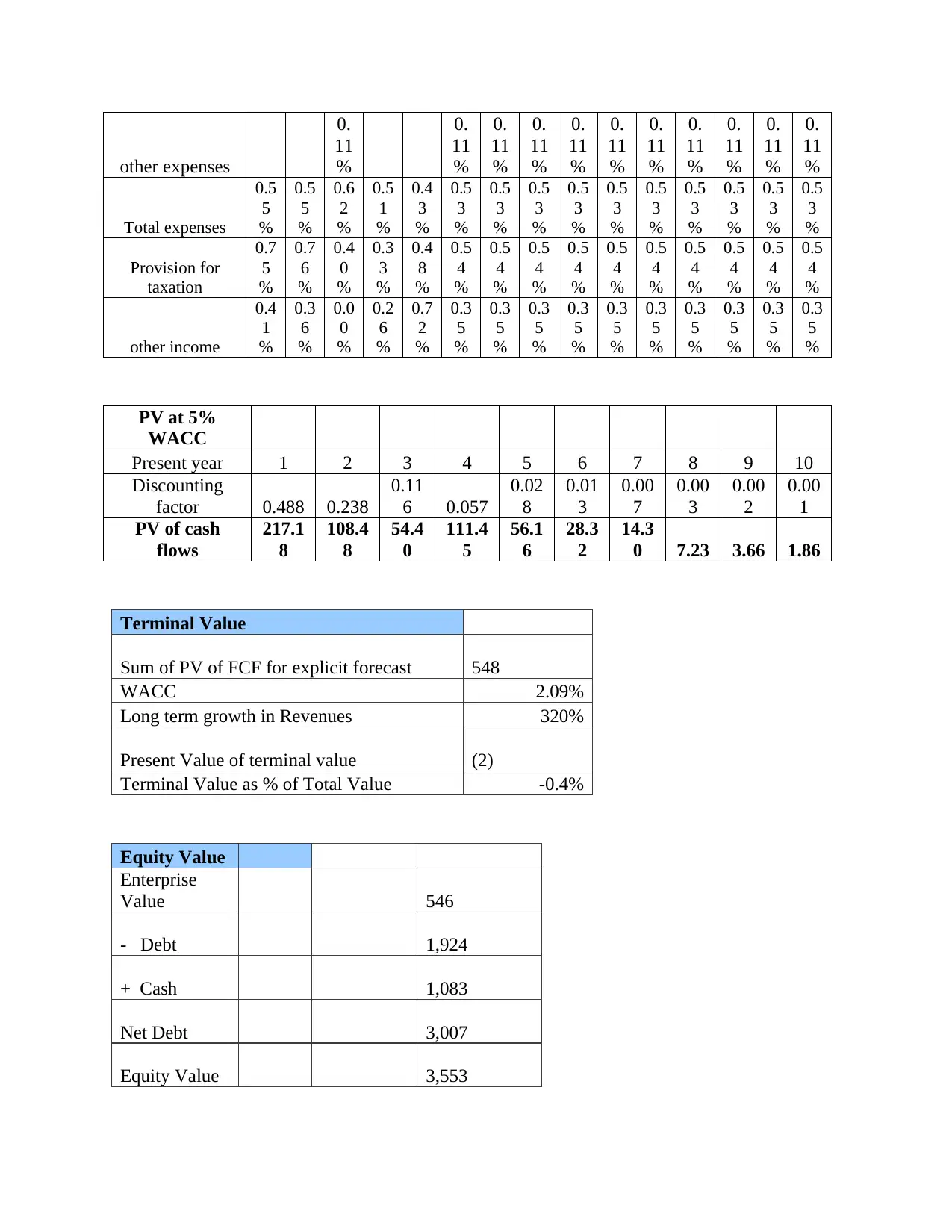
other expenses
0.
11
%
0.
11
%
0.
11
%
0.
11
%
0.
11
%
0.
11
%
0.
11
%
0.
11
%
0.
11
%
0.
11
%
0.
11
%
Total expenses
0.5
5
%
0.5
5
%
0.6
2
%
0.5
1
%
0.4
3
%
0.5
3
%
0.5
3
%
0.5
3
%
0.5
3
%
0.5
3
%
0.5
3
%
0.5
3
%
0.5
3
%
0.5
3
%
0.5
3
%
Provision for
taxation
0.7
5
%
0.7
6
%
0.4
0
%
0.3
3
%
0.4
8
%
0.5
4
%
0.5
4
%
0.5
4
%
0.5
4
%
0.5
4
%
0.5
4
%
0.5
4
%
0.5
4
%
0.5
4
%
0.5
4
%
other income
0.4
1
%
0.3
6
%
0.0
0
%
0.2
6
%
0.7
2
%
0.3
5
%
0.3
5
%
0.3
5
%
0.3
5
%
0.3
5
%
0.3
5
%
0.3
5
%
0.3
5
%
0.3
5
%
0.3
5
%
PV at 5%
WACC
Present year 1 2 3 4 5 6 7 8 9 10
Discounting
factor 0.488 0.238
0.11
6 0.057
0.02
8
0.01
3
0.00
7
0.00
3
0.00
2
0.00
1
PV of cash
flows
217.1
8
108.4
8
54.4
0
111.4
5
56.1
6
28.3
2
14.3
0 7.23 3.66 1.86
Terminal Value
Sum of PV of FCF for explicit forecast 548
WACC 2.09%
Long term growth in Revenues 320%
Present Value of terminal value (2)
Terminal Value as % of Total Value -0.4%
Equity Value
Enterprise
Value 546
- Debt 1,924
+ Cash 1,083
Net Debt 3,007
Equity Value 3,553
0.
11
%
0.
11
%
0.
11
%
0.
11
%
0.
11
%
0.
11
%
0.
11
%
0.
11
%
0.
11
%
0.
11
%
0.
11
%
Total expenses
0.5
5
%
0.5
5
%
0.6
2
%
0.5
1
%
0.4
3
%
0.5
3
%
0.5
3
%
0.5
3
%
0.5
3
%
0.5
3
%
0.5
3
%
0.5
3
%
0.5
3
%
0.5
3
%
0.5
3
%
Provision for
taxation
0.7
5
%
0.7
6
%
0.4
0
%
0.3
3
%
0.4
8
%
0.5
4
%
0.5
4
%
0.5
4
%
0.5
4
%
0.5
4
%
0.5
4
%
0.5
4
%
0.5
4
%
0.5
4
%
0.5
4
%
other income
0.4
1
%
0.3
6
%
0.0
0
%
0.2
6
%
0.7
2
%
0.3
5
%
0.3
5
%
0.3
5
%
0.3
5
%
0.3
5
%
0.3
5
%
0.3
5
%
0.3
5
%
0.3
5
%
0.3
5
%
PV at 5%
WACC
Present year 1 2 3 4 5 6 7 8 9 10
Discounting
factor 0.488 0.238
0.11
6 0.057
0.02
8
0.01
3
0.00
7
0.00
3
0.00
2
0.00
1
PV of cash
flows
217.1
8
108.4
8
54.4
0
111.4
5
56.1
6
28.3
2
14.3
0 7.23 3.66 1.86
Terminal Value
Sum of PV of FCF for explicit forecast 548
WACC 2.09%
Long term growth in Revenues 320%
Present Value of terminal value (2)
Terminal Value as % of Total Value -0.4%
Equity Value
Enterprise
Value 546
- Debt 1,924
+ Cash 1,083
Net Debt 3,007
Equity Value 3,553
Paraphrase This Document
Need a fresh take? Get an instant paraphrase of this document with our AI Paraphraser
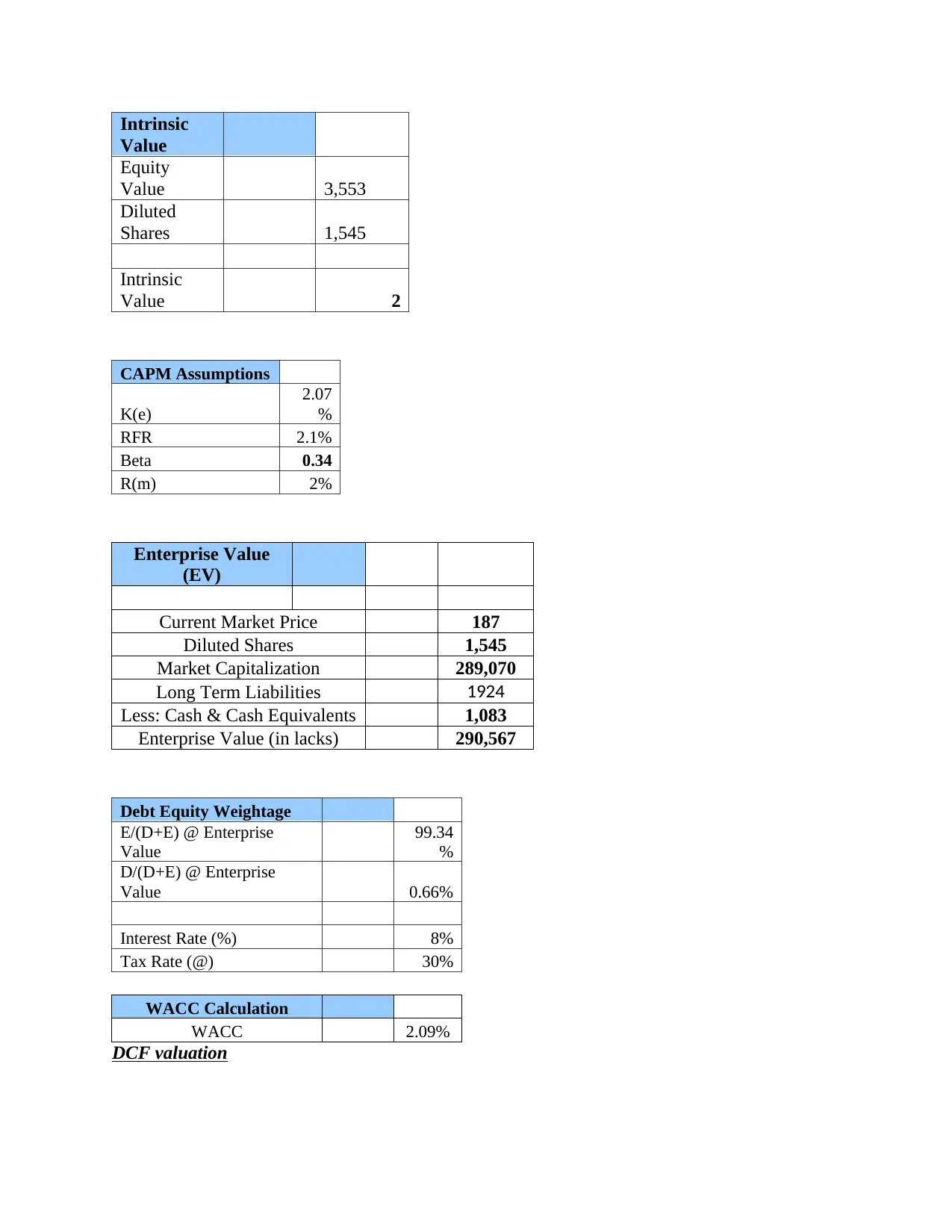
Intrinsic
Value
Equity
Value 3,553
Diluted
Shares 1,545
Intrinsic
Value 2
CAPM Assumptions
K(e)
2.07
%
RFR 2.1%
Beta 0.34
R(m) 2%
Enterprise Value
(EV)
Current Market Price 187
Diluted Shares 1,545
Market Capitalization 289,070
Long Term Liabilities 1924
Less: Cash & Cash Equivalents 1,083
Enterprise Value (in lacks) 290,567
Debt Equity Weightage
E/(D+E) @ Enterprise
Value
99.34
%
D/(D+E) @ Enterprise
Value 0.66%
Interest Rate (%) 8%
Tax Rate (@) 30%
WACC Calculation
WACC 2.09%
DCF valuation
Value
Equity
Value 3,553
Diluted
Shares 1,545
Intrinsic
Value 2
CAPM Assumptions
K(e)
2.07
%
RFR 2.1%
Beta 0.34
R(m) 2%
Enterprise Value
(EV)
Current Market Price 187
Diluted Shares 1,545
Market Capitalization 289,070
Long Term Liabilities 1924
Less: Cash & Cash Equivalents 1,083
Enterprise Value (in lacks) 290,567
Debt Equity Weightage
E/(D+E) @ Enterprise
Value
99.34
%
D/(D+E) @ Enterprise
Value 0.66%
Interest Rate (%) 8%
Tax Rate (@) 30%
WACC Calculation
WACC 2.09%
DCF valuation

Fair value of Sainsbury shares is 2 and it is trading at higher price in the market. Hence, it
can be said that shares are overvalued and are not available in market at intrinsic price. Thus, one
must not purchase Sainsbury shares.
PE ratio valuation
It can be observed that firm shares are undervalued in retail sector. As value of PE ratio is
much higher than Sainsbury PE ratio and on this basis it can be said that firm shares are valued at
appropriate price.
Reasons for difference in price
Main reason due to which price difference is observed across varied methods is that
approach of calculation is different. In specific option EPS is used for valuation then in other
approach dividend growth rate is used. Thus, inputs and calculation approach are different and
due to this reason price difference is observed across varied approaches. Out of all these methods
results produced by DCF method are accurate because in same future cash flows are taken in to
account and it are used to compute fair value of company shares on current date. Hence, it can be
said that DCF is the one of best approach then other methods. In dividend growth model, only
dividend is taken in to account. Whereas, investors investment decisions are not highly
influenced by dividend that is declared by firm. Growth prospects matter a lot for investor that is
in company then dividend. Assets value may increase or decrease and it may be part of firm
assets replacement or enhancement strategy. It does not reflect a lot about firm condition. Hence,
investment decisions cannot be taken on basis of NAV method. In DCF approach, all cash flows
are taken in to account which have direct impact on firm performance and due to this reason it is
considered as one of best method for equity valuation.
CONCLUSION
On the basis of above discussion it is concluded that Sainsbury performance was poor
and this happened because its cash flows observed sluggish growth. This create negative image
of firm among investors and they start selling its shares. Hence, value of shares declined sharply.
Multiple methods can be used to do valuation and out of all these methods DCF is one of the
most effective method because in same cash flows are taken in to account which help to identify
real value of firm shares.
can be said that shares are overvalued and are not available in market at intrinsic price. Thus, one
must not purchase Sainsbury shares.
PE ratio valuation
It can be observed that firm shares are undervalued in retail sector. As value of PE ratio is
much higher than Sainsbury PE ratio and on this basis it can be said that firm shares are valued at
appropriate price.
Reasons for difference in price
Main reason due to which price difference is observed across varied methods is that
approach of calculation is different. In specific option EPS is used for valuation then in other
approach dividend growth rate is used. Thus, inputs and calculation approach are different and
due to this reason price difference is observed across varied approaches. Out of all these methods
results produced by DCF method are accurate because in same future cash flows are taken in to
account and it are used to compute fair value of company shares on current date. Hence, it can be
said that DCF is the one of best approach then other methods. In dividend growth model, only
dividend is taken in to account. Whereas, investors investment decisions are not highly
influenced by dividend that is declared by firm. Growth prospects matter a lot for investor that is
in company then dividend. Assets value may increase or decrease and it may be part of firm
assets replacement or enhancement strategy. It does not reflect a lot about firm condition. Hence,
investment decisions cannot be taken on basis of NAV method. In DCF approach, all cash flows
are taken in to account which have direct impact on firm performance and due to this reason it is
considered as one of best method for equity valuation.
CONCLUSION
On the basis of above discussion it is concluded that Sainsbury performance was poor
and this happened because its cash flows observed sluggish growth. This create negative image
of firm among investors and they start selling its shares. Hence, value of shares declined sharply.
Multiple methods can be used to do valuation and out of all these methods DCF is one of the
most effective method because in same cash flows are taken in to account which help to identify
real value of firm shares.
⊘ This is a preview!⊘
Do you want full access?
Subscribe today to unlock all pages.

Trusted by 1+ million students worldwide
1 out of 15
Related Documents
Your All-in-One AI-Powered Toolkit for Academic Success.
+13062052269
info@desklib.com
Available 24*7 on WhatsApp / Email
![[object Object]](/_next/static/media/star-bottom.7253800d.svg)
Unlock your academic potential
Copyright © 2020–2025 A2Z Services. All Rights Reserved. Developed and managed by ZUCOL.





